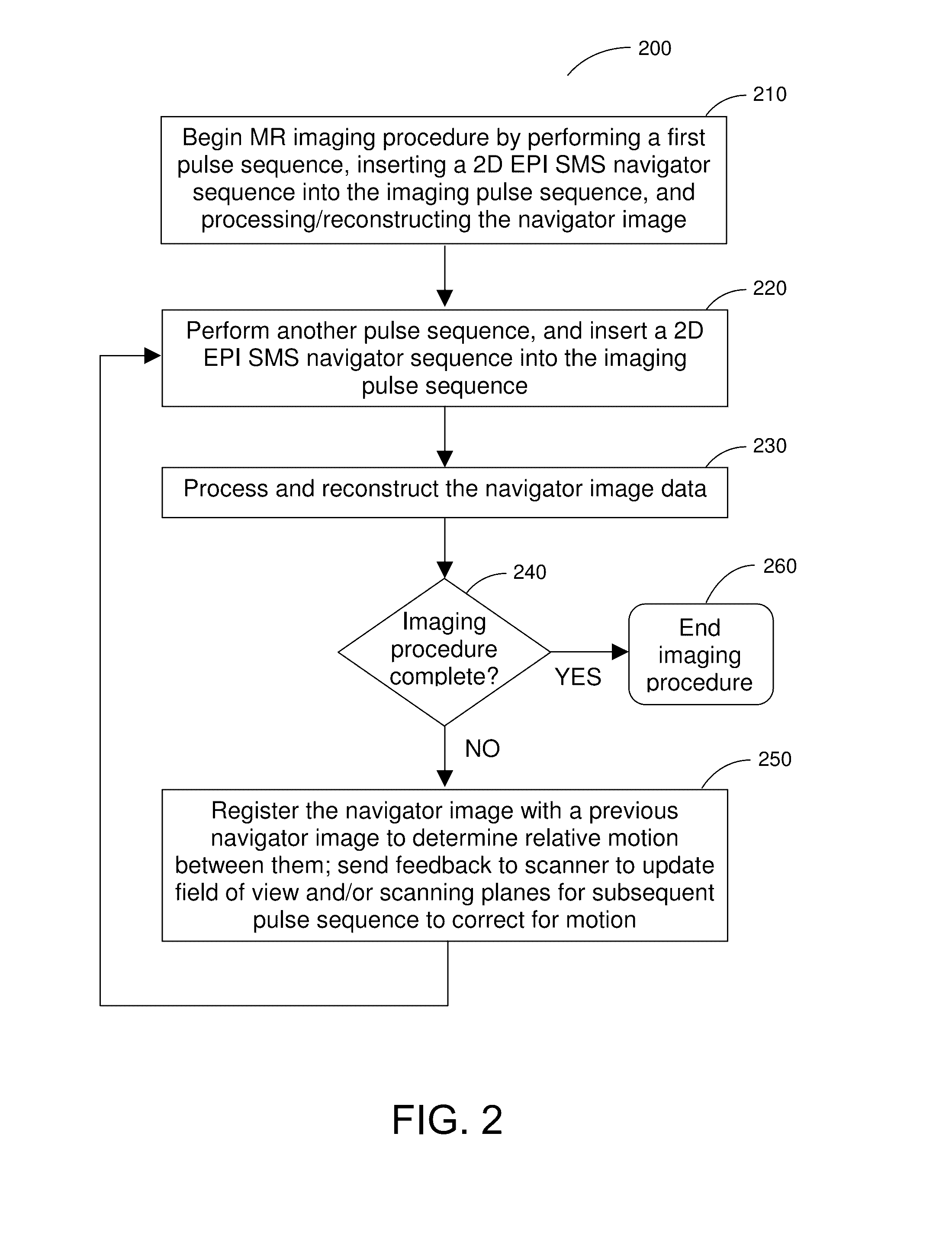Fast Prospective Motion Correction For MR Imaging
a prospective motion correction and imaging technology, applied in the direction of magnetic measurement, instruments, measurements using nmr, etc., can solve the problems of inability to diagnose images, mr imaging procedures are susceptible to motion of subjects, and imply a substantial cost in tim
- Summary
- Abstract
- Description
- Claims
- Application Information
AI Technical Summary
Benefits of technology
Problems solved by technology
Method used
Image
Examples
example 1
[0065]To demonstrate the accuracy of the prospective motion correction system and method described herein, 2D SMS EPI navigator images were acquired of two human subjects. Each subject was asked to move their head to twelve distinct positions and orientations (relative to a particular initial location) during the imaging procedure. The images were obtained using a 3T MAGNETOM® Skyra scanner (Siemens Healthcare GmbH, Erlangen, Germany). The following parameters were used to image these navigators: FOV: 256×256×80 mm3; spatial resolution: 8×8×8 mm3 (for a voxel matrix size of 32×32×10, e.g., 10 slices of 8 mm thickness); a flip angle of 10°; two-shot SMS with 5 slices excited simultaneously per shot (SMS-5); and a relative shift between slices of FOV / 4 for the blipped-CAIPI technique.
[0066]The acquisition time for each slice group consisting of 5 slices was 14 msec, leading to a total acquisition time of 28 ms for the entire navigator volume (two shots of 5 slices each).
[0067]For comp...
example 2
[0070]To provide an indication of the range of motion identifiable with the prospective motion correction system and method described herein during MR imaging, five healthy volunteers were scanned with a 2.5-minute long SMS navigator sequence during which the five subjects were instructed to freely move their heads. The navigator parameters were the same for those used in Example 1 above, i.e.: navigator image data was obtained using a 3T MAGNETOM® Skyra scanner (Siemens Healthcare GmbH, Erlangen, Germany); FOV: 256×256×80 mm3; spatial resolution: 8×8×8 mm3 (voxel matrix size of 32×32×10, with 10 slices of 8 mm thickness); a flip angle of 10°; two-shot SMS with 5 slices excited simultaneously per shot (SMS5); and a relative shift between slices of FOV / 4 for the blipped-CAIPI technique.
[0071]The navigator images were retrospectively registered to derive a range of motion estimates within which SMS navigators are expected to function accurately. The range of motion derived from the na...
example 3
[0073]To demonstrate the efficacy of the prospective motion correction system and method described herein for an MR imaging procedure, two subjects were imaged with a conventional magnetization-prepared rapid acquisition gradient echo (MPRAGE) sequence using a 3T MAGNETOM® Skyra scanner (Siemens Healthcare GmbH, Erlangen, Germany) with a 32 channel receive coil. Parameters for the MPRAGE scan were: spatial resolution: 1×1×1 mm3; GRAPPA acceleration factor: 3; total scan time: 4 minutes.
[0074]2D SMS EPI navigators in accordance with embodiments of the present disclosure were inserted into the TI gaps of the MPRAGE sequences. The following parameters were used for the navigators obtained during the MPRAGE sequences: FOV: 256×256×80 mm3; spatial resolution: 8×8×8 mm3 (voxel matrix size of 32×32×10); a flip angle of 10°; two-shot SMS with 5 slices excited simultaneously per shot (SMS-5); and a relative shift between slices of FOV / 4 for the blipped-CAIPI technique.
[0075]During each TR a ...
PUM
 Login to View More
Login to View More Abstract
Description
Claims
Application Information
 Login to View More
Login to View More - R&D
- Intellectual Property
- Life Sciences
- Materials
- Tech Scout
- Unparalleled Data Quality
- Higher Quality Content
- 60% Fewer Hallucinations
Browse by: Latest US Patents, China's latest patents, Technical Efficacy Thesaurus, Application Domain, Technology Topic, Popular Technical Reports.
© 2025 PatSnap. All rights reserved.Legal|Privacy policy|Modern Slavery Act Transparency Statement|Sitemap|About US| Contact US: help@patsnap.com



